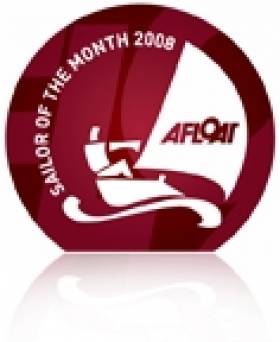Displaying items by tag: afloat sailor of the year
Mark Mills is Sailor of the Year 2009
Celebrating a designer as a top sailor may seem unusual, but even in today’s specialized world a successful sailor is capable of many tasks afloat. And equally, a successful designer must be a high achieving sailor in the first place in order to meet the hugely varying demands of his profession. Over the years, designers such as America’s Cup legend Nat Herreshoff have shown themselves well able afloat. Olin Stephens made his name by winning the Fastnet Race twice as helm and crew on boats of his own design, Ron Holland made his mark skippering his own boat to win the Quarter Ton Worlds in 1973, Doug Peterson likewise sailed to world standard, and Rob Humphreys began his design career with wins from his home port of Pwllheli on the Welsh coast.
When we made Mark Mills Sailor of the Month a year ago, it was in celebration of his success during 2008 – mostly with Cork owners – in boats which included Eamonn Rohan’s Blondie, first out of the mould of the Argentine-built Mills-designed King 40 production class.
The King 40 began to win in many events internationally, and in October 2008, it became Boat of the Year at the big exhibition in the US, the Annapolis Boat Show. Demand was such that production was moved to America, where a smaller sister, the Summit 35, was already being developed. The King 40 became the Summit 40, and success continued worldwide. Meanwhile the 2009 season was leaping to life, and Mills designs were hitting the headlines, most notably in Ireland where Dave Dwyer’s Mills 39 marinerscove.ie continued her successful progress, while visiting King 40s lifted class titles in the Volvo Dun Laoghaire Regatta and the Sovereign’s Cup at Kinsale.
However, there was only one Mills entry in the Fastnet Race, a DK 46 of 2003 vintage, so the lack of a serious challenge in that iconic event prompted suggestions that Mills boats were extreme racing machines in which crews were unwilling to campaign flat out in true offshore conditions. That was triumphantly refuted in the 620-mile Middle Sea Race out of Malta in November. The superb Mills-designed 68-footer Alegre (Andy Soreano) won overall in rugged conditions, beating the Fastnet winner Ran (a 72-footer) on a boat-for-boat basis.
It was a magnificent achievement, but the Mark Mills success wave was progressing on other fronts. The new Summit 35 became Boat of the Show at Newport in the US, while Kings 40s and Summit 40s were winning all over the world, the Summit 40 showing her quality by launching into 2010 with another win at January’s Key West Regatta.
Mark Mills goes all over the world to meet builders and owners and take in regattas and major races. But his base is in Wicklow – in the northwest of the county where the hills are beginning to become the Wicklow Mountains. In addition to his proven racing range, current projects include a 90-metre sloop, which will have a mast-top above the usual cloud base. In all, it’s a body of work of exceptional quality. Only a very able sailor could create the ideas, and see them through to completion, and Mark Mills is most deservedly our new Sailor of the Year.





























































